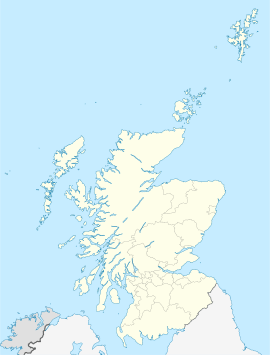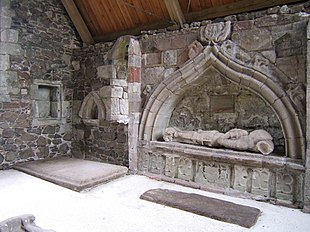Rothesay (Schottland)
| Rothesay schottisch-gälisch Baile Bhòid | ||
|---|---|---|
 | ||
| Koordinaten | 55° 50′ N, 5° 3′ W | |
| Traditionelle Grafschaft | Bute | |
| Einwohner | 4637 Zensus 2011 | |
| Verwaltung | ||
| Post town | ISLE OF BUTE | |
| Postleitzahlenabschnitt | PA20 | |
| Vorwahl | 01700 | |
| Landesteil | Schottland | |
| Council area | Argyll and Bute | |
| Britisches Parlament | Argyll and Bute | |
| Schottisches Parlament | Argyll and Bute | |
Rothesay [], schottisch-gälisch Baile Bhòid,[1] ist die Hauptstadt der Isle of Bute im schottischen Council Area Argyll and Bute. Das Zentrum der Stadt bildet Rothesay Castle, eine Schlossruine, die aus dem 13. Jahrhundert stammt und einen für Schottland einzigartigen kreisförmigen Grundriss besitzt.
Rothesay hat 4637 Einwohner (Stand 2011).[2]
Geschichte
Die zerstörte neolithische Siedlung von Townhead lag unter dem modernen Friedhof und der angrenzenden St. Mary’s Chapel am südlichen Stadtrand von Rothesay.
Söhne und Töchter der Stadt
- William Leitch (1814–1864), britischer Astronom, Naturforscher, Mathematiker und presbyterianischer (reformierter) Geistlicher der Church of Scotland
- William Macewen (1848–1924), schottischer Chirurg
- Troy Kennedy Martin (1932–2009), britischer Drehbuchautor
- Ian Jenkins (* 1941), schottischer Politiker
- George Lyon (* 1956), schottischer Politiker
- Graham Watson (* 1956), britischer Europapolitiker
- Johnny Dumfries (1958–2021), britischer Automobilrennfahrer
- Eleanor Campbell (* 1960), britische physikalische Chemikerin
- Lena Zavaroni (1963–1999), britische Sängerin und Kinderstar
- Ashley Lilley (* 1986), schottische Schauspielerin
- Jane Ross (* 1989), schottische Fußballspielerin
Siehe auch
Literatur
- Alison Weir: Britain's Royal Families. The Complete Genealogy, London 2002, ISBN 0-7126-4286-2
Einzelnachweise
Weblinks
- Eintrag zu Rothesay in Canmore, der Datenbank von Historic Environment Scotland (englisch)
Auf dieser Seite verwendete Medien
(c) Barbara Carr, CC BY-SA 2.0
The Knight's Grave, St Mary's Chapel. St Mary's Chapel, in the churchyard of the High Kirk, Rothesay 1289836, was repaired by the order of the Marquess of Bute in May 1817. It contains two elaborate graves - this one of the knight being on the western side: the other, of a lady and child, is on the opposite wall - and other gravestones, both vertical and horizontal. The information-board tells us that "the effigy is of a knight in complete plate armour, his head resting on a helmet crested with a dog's head, his feet on a lion. From the jewelled belt around his waist hang a sword and a dagger". The coat of arms on the tomb indicates that the knight was part of the House of Stewart - it's possible that Robert II built the tomb for himself or his family: but he is buried at Scone, so perhaps the tomb was used for the Sheriffs of Bute. In the wall can be seen the piscina (for washing holy vessels) and an aumbry (small recess or cupboard).
(c) Eric Gaba, NordNordWest, CC BY-SA 3.0
Positionskarte von Schottland, Vereinigtes Königreich




